Writing The Story
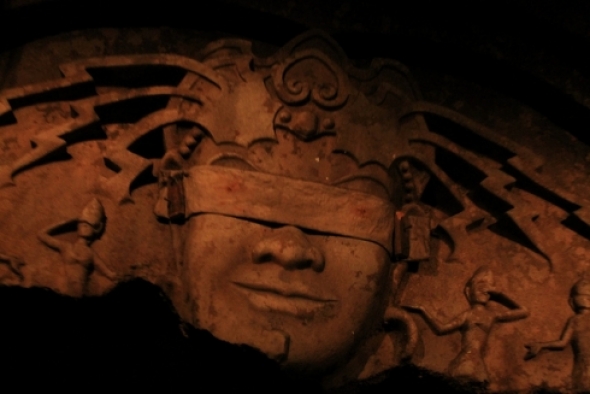 Though Mara is depicted time and time again in the ride's half-mile-long queue, he is always shown with eyes closed or covered. A sign of things to come. © Disney.
Though Mara is depicted time and time again in the ride's half-mile-long queue, he is always shown with eyes closed or covered. A sign of things to come. © Disney.
Dodging booby traps, careening through crumbling caverns, and avoiding the deadly gaze of a crazed ancient god... It might not sound like what you'd expect from an attraction at Disneyland, and you'd be right. There's no denying that Indiana Jones Adventure is backed by a dark, twisted, and legitimately unsettling mythos that practically deserves a full-length Indiana Jones feature of its own.
The ride was conceived by a partnership between Disney Imagineers and George Lucas, a full two decades before Disney would purchase Lucasfilm and its intellectual properties outright.
It wasn't the first time that the two entertainment giants collaborated. In fact, it was all a part of the grand vision of Michael Eisner, who had joined the Walt Disney Company as CEO in 1984. Fresh from a stint as the CEO of Paramount Pictures (coincidentally, the distributor of Raiders of the Lost Ark), Eisner had a certain sense for the entertainment industry. Fittingly, he happened to believe (wildly and unimaginably so at the time) that Disneyland could be a place where you could "ride the movies." And – even more sacrilegiously – that they didn't necessarily have to be Disney movies.
Allegedly, soon after his arrival at The Walt Disney Company, Eisner was due for his first escorted tour of Disneyland. He invited his teenage son, Breck, who responded, "That place is lame, dad."
Horrified, Eisner was determined to change Disneyland's reputation and make it a place that could entertain every member of the family – even teenagers – and he believed that movies were the way to do it.
Eisner's first reach outside of Disney's canon was George Lucas. Lucas collaborated in the creation of Captain EO (1986) while he and Imagineers worked to develop their real homerun, Star Tours (1987). Under Eisner's guidance, Walt Disney World prepped to open its third theme park, the appropriately cinematic Disney-MGM Studios Park, which would count among its opening day attractions a stunt show based on Lucas' Raiders of the Lost Ark and its runaway hero: The Indiana Jones Epic Stunt Spectacular (1989). Just a few years later, they'd work together again in the creation of Disney's scariest attraction ever, The ExtraTERRORestrial Alien Encounter (1994).
But the reinvention of Disneyland as a thrilling place with larger-than-life adventures was not yet complete. For that, Eisner and Lucas had an even more elaborate plan. Borrowing from the dark tone and styling of Indiana Jones and the Temple of Doom, Imagineers developed plans to expand and redress a portion of Disneyland's Adventureland into an entire indoor Indiana Jones sub-land called The Lost Expedition.
This never-built project would've been impressive, featuring a wild indoor mine-cart roller coaster, a rerouted Jungle Cruise and Disneyland Railroad passing through the gigantic indoor sub-land, and a wild off-roading dark ride through a collapsing temple.
Unfortunately, The Lost Expedition never came to pass. But one element of it (the off-roading dark ride) did stick with Imagineers until – under the guidance of Tony Baxter – it evolved into Indiana Jones Adventure: Temple of the Forbidden Eye. We can't know for sure what The Lost Expedition's dark ride would've been like, but it's doubtful that it could've exceeded the scope of Forbidden Eye, so at least there's some assurance there.
Mara's Legacy
Indiana Jones Adventure set a new standard for themed entertainment. Its “motion base” capabilities were absolutely revolutionary, and came four years before Universal did the same with The Amazing Adventures of Spider-Man. (In fact, the designers of Universal's famed Spider-Man attraction specifically credit the opening of Indiana Jones Adventure as pushing them back to the drawing board to improve their own designs, leading to the groundbreaking motion-base technology at Islands of Adventure).
Still, Disney wasn't done innovating on its own EMV technology.
Indiana Jones Adventure has never been duplicated at Walt Disney World. However, when Disney's Animal Kingdom opened in 1998, it, too, had an EMV dark ride: Dinosaur.
The EMVs are a dead giveaway that the two rides use the same motion-simulating base, so that's probably not surprising. What might surprise you is that Dinosaur doesn't just re-use Indy's vehicles; it features an almost bolt-for-bolt identical clone of Indiana Jones' track layout! Though you'd never guess it (since Dinosaur spends its time racing through claustrophobic, pitch-black jungle scenes), the two rides' layouts are almost exactly identical (Dinosaur cut a few literal corners where they weren't needed), and those who have ridden both can easily point out a few "shared moments" in the track that are evidence of that, even with such different dressing around it.
You probably won't see much fanfare about Dinosaur, though. It's not that Dinosaur is a bad ride (it's absolutely not), but knowing that it's just one redress away from Indiana Jones Adventure leads to painful comparisons for those who have ridden both.
In 2001, Tokyo DisneySea opened with Indiana Jones Adventure: Temple of the Crystal Skull (unrelated to the similarly-named feature film, which was released later) that is nearly identical to the California adventure. However, Tokyo's is set in South America rather than India, necessitating a few changes. Mara is replaced by a malevolent Crystal Skull (which, funny enough, still shoots deadly beams of light from a single corroded eye socket; see above) and the three doors are replaced by a single one: the legendary Fountain of Youth.
Like most of DisneySea's rides, their Indiana Jones Adventure appears to have had a plush budget with even more details and textures, but something about the Forbidden Eye storyline and the three gifts pushes California's ahead in our books.
Even with its groundbreaking technology, one of the ride's real successes is in its storytelling. Though it may not contain the overtly simple, low-key special effects of Haunted Mansion or Pirates of the Caribbean (instead opting for in-your-face excitement), Indiana Jones Adventure did something few other dark rides had done – it made you, the guest, part of the story. On Haunted Mansion, Pirates, or many of Fantasyland’s dark rides, the story plays out, with you as a silent observer. On Indiana Jones Adventure, you are the reason for the temple’s collapse. You looked into Mara’s eyes. You triggered the booby trap. That immersion has now become industry-standard for many rides.
Your Adventure Begins
Even twenty years after its debut, Indiana Jones Adventure remains one of the most technologically advanced, enigmatic, and energetic rides ever built. It's a cornerstone of Disneyland's already-impressive ride line-up, and certainly tells one of the most innovative and engaging stories ever developed for an attraction. It's a stunning, larger-than-life, brilliant adventure from beginning to end.
Below, you'll find three on-ride videos – one for each of Mara's gifts – that do an impossibly good job of capturing the grand experience of Indiana Jones Adventure: Temple of the Forbidden Eye. It goes without saying that the videos (expertly filmed with extreme low light cameras) may spoil a bit of the illusion, but if you've made it this far on our Behind the Ride tour, it's too late to care much about that now! In the comments below, tell us your memories of Indiana Jones Adventure and which of the three destinies is your favorite!
Chamber of Earthly Riches:
Observatory of the Future:
Grotto of Eternal Youth:
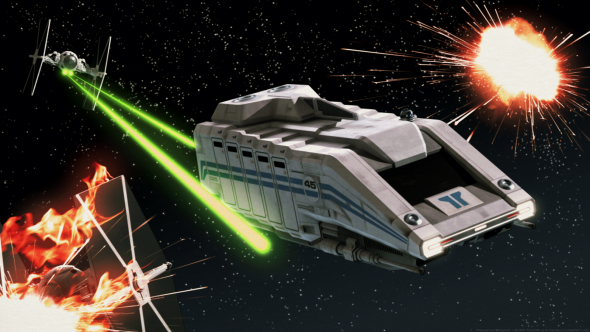
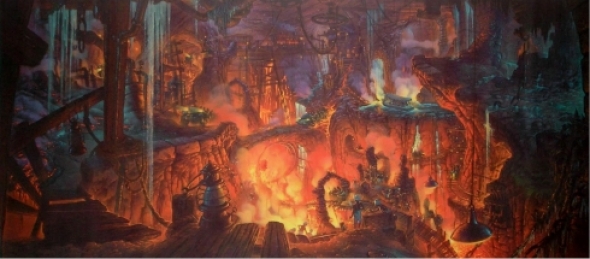
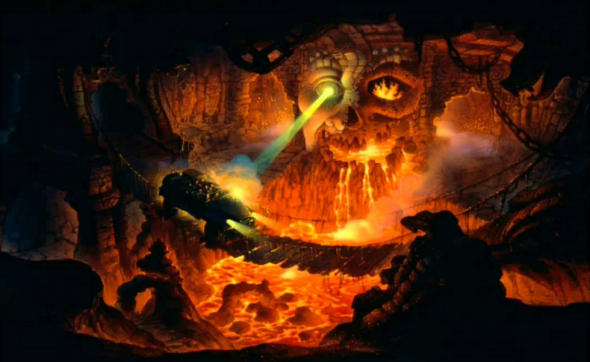
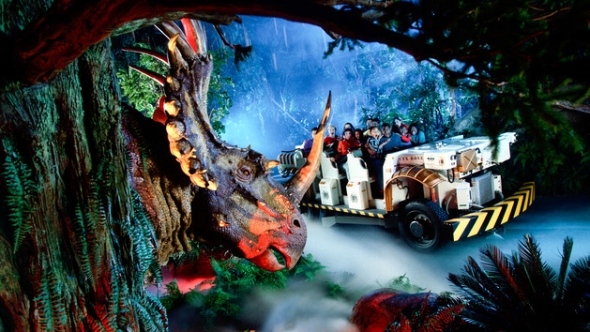
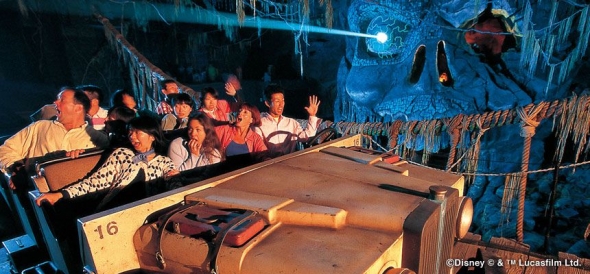

Comments
Hey love Indiana Jones and ride eyes Mara
Riding the ride isn't nearly as exciting as reading about it. When I went last year, it sucked. First off, the ride kept having mechanical failures, second, you could barely understand what the God was saying over all the other noise, and as far as the vehicles go, if they are different, they move too fast for you to really notice.All in all, the ride could've been much bigger, much longer, and much better, giving people more time to take in the things ranter than throwing them about. Otherwise, it was good, and worth maybe a 10 minute wait, at longest, 15 or 30.
The unique personification of the ride vehicle itself sounds interesting, like the different vehicle reactions such as "being afraid of the dark". Something very subtle that I never noticed. I'm DEFINITELY going to have to check that out soon next time I go.